Posted by: site admin @ 6:50 am
𝓛𝓔𝓢𝓢𝓞𝓝 4140 Tue 2 Nov 2021
Today to save Democracy Freedom, Liberty, Equality and Fraternity all
fraud EVMs must and should be replaced by BALLOT PAPERS.
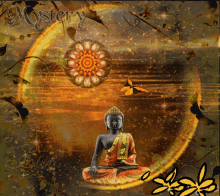

Grow Broccoli
 Bell Pepper
Bell Pepper  Cucumber
Cucumber  Carrots
Carrots  Beans in pots.
Beans in pots.
 Sujata fed Buddha to overcome hunger
Sujata fed Buddha to overcome hunger
 Ashoka planted fruit bearing trees all over his Mauryan Empire.
Ashoka planted fruit bearing trees all over his Mauryan Empire.
 Mayawati wants to establish that Mauryan Empire.
Mayawati wants to establish that Mauryan Empire.

3. Dr B.R.Ambedkar thundered “Main Bharat Baudhmay karunga.” (I will make this country Buddhist)
All Aboriginal Awakened Societies Thunder ” Hum Prapanch Prabuddha
Prapanchmay karunge.” We will make the whole world Prabuddha Prapanch Universe.
Grams at $62.00 which plays a role in generating energy in the human
body available ‘for the price of a coffee a day’ a Stunning anti-ageing
breakthrough could see humans live to 150
years and regenerate organ.New process has been
found by Harvard Professor David Sinclair and researchers from the
University of New South Wales, involving cell reprogramming.
to the University of Singapore survey/review based on 131 countries.
From June 18, world will be 100% free and happy from December 8th. Their
predictions about Italy and Spain fit exactly.
5. Maker of COVID Tests Says Pandemic is Biggest Hoax Ever
Perpetrated It is like a blind man searching for a black cat in a dark
room which is not there.
WORLD WILL BE FREE FROM HOAX - STRENGTHENING THE TRUST FOR BEST OF HEALTH -SINGAPORE UNIVERSITY SURVEY

After Bath Practice Patanjali Yogic Meditation From 04:00 AM to 05:00 AM at
𝙆𝙪𝙨𝙝𝙞𝙣𝙖𝙧𝙖 𝙉𝙄𝘽𝘽Ā𝙉𝘼 𝘽𝙃𝙐𝙈𝙄 𝙋𝙖𝙜𝙤𝙙𝙖
18𝙛𝙩 𝘿𝙞𝙖. 𝙖 3𝘿 360 𝙙𝙚𝙜𝙧𝙚𝙚 𝙘𝙞𝙧𝙘𝙪𝙡𝙖𝙧 𝙋𝙖𝙜𝙤𝙙𝙖 𝙖𝙩
𝙒𝙝𝙞𝙩𝙚 𝙃𝙤𝙢𝙚,
668 5𝙩𝙝 𝘼 𝙈𝙖𝙞𝙣 𝙍𝙤𝙖𝙙,
8𝙩𝙝 𝘾𝙧𝙤𝙨𝙨, 𝙃𝘼𝙇 𝙄𝙄𝙄 𝙎𝙩𝙖𝙜𝙚,
𝙋𝙪𝙣𝙞𝙮𝙖 𝘽𝙃𝙐𝙈𝙄 𝘽𝙚𝙣𝙜𝙖𝙡𝙪𝙧𝙪,
𝙈𝙖𝙜𝙖𝙙𝙝𝙞 𝙆𝙖𝙧𝙣𝙖𝙩𝙖𝙠𝙖,
𝙋𝙧𝙖𝙗𝙪𝙙𝙙𝙝𝙖 𝘽𝙝𝙖𝙧𝙖𝙩 𝙄𝙣𝙩𝙚𝙧𝙣𝙖𝙩𝙞𝙤𝙣𝙖𝙡

𝙗𝙪𝙙𝙙𝙝𝙖𝙨𝙖𝙞𝙙2𝙪𝙨@𝙜𝙢𝙖𝙞𝙡.𝙘𝙤𝙢
𝙟𝙘𝙨4𝙚𝙫𝙚𝙧@𝙤𝙪𝙩𝙡𝙤𝙤𝙠.𝙘𝙤𝙢
𝙟𝙘𝙝𝙖𝙣𝙙𝙧𝙖𝙨𝙚𝙠𝙝𝙖𝙧𝙖𝙣@𝙮𝙖𝙝𝙤𝙤.𝙘𝙤𝙢
080-25203792
9449260443
9449835875
Spread the Words of Buddha from
𝙝𝙩𝙩𝙥://𝙨𝙖𝙧𝙫𝙖𝙟𝙖𝙣.𝙖𝙢𝙗𝙚𝙙𝙠𝙖𝙧.𝙤𝙧𝙜, WhatApp, Telegram,Facebook, Twitter, more than 5000 Emails.
Practicing Mindful Swimming at Dolphin Aquatics at Halasuru from 05:30 AM to 07:00 AM
 Vegan
Vegan  ақ үй
ақ үй 
 Bell Pevpers
Bell Pevpers қияры
қияры  сәбіз
сәбіз  сәбіз
сәбіз  Кәстрөлдердегі бұршақтар
Кәстрөлдердегі бұршақтаралты саласы, Бхиккк, жақсы бақыланатын, жақсы қорғалған, жақсы
қорғалған, жақсы ұсталған, әл-ауқат әкеліңіз. Қайсысы?
құлақ, мұрын, тіл, дене, бөрік, Бхикк, жақсы басқарылады, жақсы
қорғалған, жақсы қорғалған, жақсы қорғалатын, жақсы ұсталған, амандық
әкеледі.
Bhikkhus
ដែលត្រូវបានគ្រប់គ្រងយ៉ាងល្អដែលត្រូវបានការពារយ៉ាងល្អការពារបានល្អការពារបានល្អអាចនាំមកនូវសុខុមាលភាព។
មួយណាប្រាំមួយ?
savong dharma,buth savong talk, buth savong live,Buddha history, buth
savong audio,buth savong channel,buth savong sound,buth savong keatha,
buth savong…
 Bell Peppers
Bell Peppers Cucumber
Cucumber  karoti
karoti  ibishyimbo mumasafuriya
ibishyimbo mumasafuriyanzego esheshatu zo kuvugana, Bhikkhus, ziyobowe neza, zirinzwe neza,
zirindwa neza, zabujijwe neza, zizana imibereho myiza. Niyihe batandatu?
#호흡법 #수행 #차크라 #복식호흡 #단전호흡호흡은 들숨과 날숨의 대칭으로 되어 있습니다. 호흡의 대칭은 생존을 위한 것인데,
이는 곧 생각의 대칭에도 직결합니다. 생각의 대칭을 깨기 위해서는 그 보급로인 호흡의 …..
şeş deverên têkiliyê, Bhikkhus, baş tê kontrolkirin, baş parastin, baş
parastin, baş parastin, başbûn û başbûnê bînin. Kîjan şeş?
guh, poz, laş, laş wekî qadek têkiliyê, Bhikkhus, baş tê kontrol kirin,
baş parastin, baş, baş, baş parastin, baş sînordar, başbûnê tîne.
 Vegan
Vegan  White Home
White Home 
 Bell Peppers
Bell Peppers бадыраң бадыраң
бадыраң бадыраң  сабиз
сабиз  казандагы буурчак
казандагы буурчакбул алты чөйрөсү, Бхикхус жакшы башкарылган, жакшы кайтарылган, жакшы
корголгон, жакшы корголгон, жакшы сакталган, жакшы көңүл бурулган. Алты
ким?
кулак, мурун, тил, тил тийген, Бихикхус, жакшы көзөмөлдөнгөн, жакшы
кайтарылган, жакшы корголгон, жакшы корголгон, жакшы көңүл бурулган,
жакшы корголгон.
-
62) Classical Lao-ຄລາສສິກລາວ,
Srimala Sutra: All 15 Chapters [English Tathagatagarbha Sutras Audiobook] (1080P)Dharmachakra Wheel of the Dharma9.08K subscribersDifficulty level 難度級別 4.0/500:00 Ch.1 The Merits of the Tathāgata’s True Dharma06:38 Ch.2 The Ten Ordination Vows12:21 Ch.3 The Three Great Vows14:03 Ch.4 Acceptance of the True Dharma29:58 Ch.5 The One Vehicle53:58 Ch.6 The Unlimited Noble Truths56:56 Ch.7 The Tathāgatagarbha58:25 Ch.8 The Dharma Body1:02:42 Ch.9 The Underlying Truth: The Meaning of Emptiness1:04:40 Ch.10 The One Noble Truth1:05:53 Ch.11 The One Refuge1:06:48 Ch.12 The Contrary Truths1:12:07 Ch.13 The Inherently Pure1:17:37 Ch.14 The True Sons [and Daughters] of the Tathāgata1:20:36 Ch.15 ŚrīmālāSrimala Sutra: All 15 Chapters [English Tathagatagarbha Sutras Audiobook] (1080P) 勝鬘師子吼一乘大方便方廣經 全經十五章Access here for non-background music videos, please scroll to the bottom of the list 以下連結擁有沒有背景音樂的純讀經片段 請滾動到列表的最下方618 / 5000Translation resultsນົກຫຼິ້ນຟຣີນົກ Vegan
Vegan  ເຮືອນສີຂາວ
ເຮືອນສີຂາວ ເຮັດແນວຄິດທີ່ດີທີ່ສຸດ - ເສັ້ນທາງສູ່ Bliss ນິລັນດອນຄວາມອຶດຕິກແມ່ນຄວາມເຈັບປ່ວຍທີ່ບໍ່ດີທີ່ສຸດຂອງພຣະພຸດທະເຈົ້າປູກ broccoli
ເຮັດແນວຄິດທີ່ດີທີ່ສຸດ - ເສັ້ນທາງສູ່ Bliss ນິລັນດອນຄວາມອຶດຕິກແມ່ນຄວາມເຈັບປ່ວຍທີ່ບໍ່ດີທີ່ສຸດຂອງພຣະພຸດທະເຈົ້າປູກ broccoli ລະຄັງpeppers
ລະຄັງpeppers ແຕງ
ແຕງ carrots
carrots  ຖົ່ວເຫຼືອງຖົ່ວການຕິດຕໍ່ຫົກຢ່າງນີ້,
ຖົ່ວເຫຼືອງຖົ່ວການຕິດຕໍ່ຫົກຢ່າງນີ້,
Bhikkhus, ກໍາລັງຄວບຄຸມໄດ້ດີ, ມີການເຝົ້າລະວັງເປັນຢ່າງດີ,
ປົກປ້ອງເປັນຢ່າງດີ, ຖືກປົກປ້ອງເປັນຢ່າງດີ, ໃຫ້ມີຄວາມສະບາຍດີ. ເຊິ່ງຫົກ?ພະພຸດທະເຈົ້າຂອງຕົນເອງໃນ SN 35.94 (s IV 69)Adantāgutta Suttera- Laontrolled ແລະ Unguarded-suraardical- ພາສາລາວ - ການຍຶດຄູ່ອາກາດລາວຕາ,
ຫູ, ດັງ, ລີ້ນ, ຮ່າງກາຍເປັນຂອບເຂດຂອງການຕິດຕໍ່, ການຄວບຄຸມໄດ້ດີ,
ປ້ອງກັນໄດ້ດີ, ຖືກປົກປ້ອງເປັນຢ່າງດີ, ເຮັດໃຫ້ສະບາຍດີ, ມີຄວາມສຸກດີ.Please visit the reciter’s video! 歡迎參觀讀經者的片段!Sutra of Queen SrimalaThis is a joint project between acalaacala and Dharmachakra Wheel of the Dharma這是一個由兩個頻道發起的合作Permission is obtained from BDK to produce this video此影片的制作已經獲得BDK的授權Please visit the English website!歡迎參觀相應的英語網址!Source of this English Sutra英語佛經出處Paul,
D. and McRae, J. (2004). The Sutra of Queen Śrīmālā of the Lion’s Roar;
The Vimalakīrti Sutra. Berkeley, Calif.: Numata Center for Buddhist
Translation and Research. ISBN: 978-1-886439-31-3Mahayana Buddhism Sutras (English Audiobook or Videobook) 英語佛經 (漢傳佛經)Theravada Buddhism Suttas (English Audiobook) 英語佛經 (南傳佛經)Other Chinese sutras 其他華語佛經Click this link to watch other Buddhism animations 按此連結有其它的佛教動畫Download the latest version of the video and the portable document format (pdf)按此下載最新的影片和可攜式文件格式 (pdf)Please request by writing your email address in the comment section.如需要,請在留言格中留下你的電子郵件地址This sutra is available in Chinese.Please click this link.華語版可從以下連結進入Please search 請瀏覽: http://www.xianmijingzang.com/本片段有大量注釋, 有興趣的人如果要閱讀它們, 可以把片段先行暫停, 再仔細閱讀“Dharmachakra Wheel of the Dharma” channel and other websites本頻道的其他網站Any thoughts? Please feel free to write in the comment box below, we will reply to you as soon as possible.在想什麽嗎? 盡情寫在留言格中 我們會盡快回覆Music in this videoLearn moreListen ad-free with YouTube PremiumSong月下流泉 (feat. 曹杨, 刘蔓, 李鹏, 侯长青)Artist巫娜Album天禅 (feat. 李鹏, 曹杨, 侯长青) [古琴-壹]Licensed to YouTube byBelieve Music (on behalf of 龙源音乐), and 1 Music Rights SocietiesSrimala Sutra: All 15 Chapters [English Tathagatagarbha Sutras Audiobook] (1080P)
-
63) Classical Latin-LXII) Classical Latin,
Liberum aves vegan
vegan  alba Domus
alba Domus  Fac bonum purificare mens - iter ad aeternam beatitudinemFames est pessimus genus morbo dicitur BuddhaCrescere broccoli
Fac bonum purificare mens - iter ad aeternam beatitudinemFames est pessimus genus morbo dicitur BuddhaCrescere broccoli bell piperit
bell piperit cucumis
cucumis  carrots
carrots  fabam in ollisHi
fabam in ollisHi
sex sphaerae contactus, Bhikkhus, cum bene regitur, bene
custodiebantur, bene protected, bene moderatur, producat bene esse. Quod
sex?Buddha propria verba in sn 35.94 (S III LXIX)Adantāgutta Sutta- UnguDarded -classical Latin-Lxii et Unguarded) Latin LatinEt
oculus, auris, nasum, lingua, corpus quasi sphaera contactus, Bhikkhus,
bene regitur, bene custoditus, bene protected, bene coercuit, bene
esse.AWAKENING FROM THEDREAM OF EXISTENCE by Bhante Punnaji @Shanthi Nikethanaya Buddhist Center, CA, USABhante PunnajiAWAKENING FROM THEDREAM OF EXISTENCEVen Dr M Punnaji Maha TheraSunday, November 3rd 2013Shanthi Nikethanaya Buddhist Center22543 Marlin Place, West Hills, CA 91307. U.S.A.
shanthinikethanaya.comFor the highest form of human intellectVenerable
Master Shantha Sobhana is a Buddhist monk with 25 years of experience
in meditation and healing techniques, who has also been practicing and
teaching yoga for the past 15 years. He has international experience
including China, Malaysia, United Kingdom, Europe, India and Sri Lanka.
-
64) Classical Latvian-Klasiskā latviešu valoda,
Bezmaksas putni Vegan
Vegan  White Home
White Home  Darīt labu attīrīt prātu - ceļš uz mūžīgo svētlaimiBads ir sliktākais slimības veids, ko teica BuddhaAugt brokoļi
Darīt labu attīrīt prātu - ceļš uz mūžīgo svētlaimiBads ir sliktākais slimības veids, ko teica BuddhaAugt brokoļi bell peppers
bell peppers gurķi
gurķi  burkāni
burkāni  pupiņas podosŠīs sešas saskares, Bhikkhus, labi kontrolēta, labi apsargāta, labi aizsargāta, labi ierobežota, labi aizsargāta. Kas seši?Budas paša vārdi SN 35,94 (S IV 69)Adantāgtta Sutta- nekontrolēta un neapsargāta -Classical latviešu-klašauka latviešu valodaAcs,
pupiņas podosŠīs sešas saskares, Bhikkhus, labi kontrolēta, labi apsargāta, labi aizsargāta, labi ierobežota, labi aizsargāta. Kas seši?Budas paša vārdi SN 35,94 (S IV 69)Adantāgtta Sutta- nekontrolēta un neapsargāta -Classical latviešu-klašauka latviešu valodaAcs,
auss, deguns, mēle, ķermenis kā sfēra kontakta, bhikkhus, labi
kontrolēta, labi apsargāta, labi aizsargāta, labi ierobežota, rada
labklājību.Sacred Chants Of Tibet - The Gyuto Monks Tantric ChoirNext Level Meditation47.1K subscribersThe Perfect Jewel: Sacred Chants Of Tibet by The Gyuto Monks Tantric Choir00:00 Initiation Ceremony of Guhyasamaja Tantra;05:40 Offering of Seven Royal Emblems;14:14 Consecration Ceremony of Yamantaka “Raining Good Fortune”;25:43 Eighty Thousand Obstructions28:02 Offering of Tea;29:32 Mahakala Chanting;47:41 Praise and Request to Kalarupa…Now free meditation e-books: https://nextlevelmeditation.org/Facebook group: https://www.facebook.com/groups/nextlInstagram: https://www.instagram.com/truenextlevelTo help my work: https://www.buymeacoffee.com/nextlevelGyuto (also spelled Gyütö or Gyüto) Tantric University is one of the great monastic institutions of the Gelug Order.Gyuto
(Tibetan རྒྱུད་སྟོད་ , Wylie rGyud sTod) was founded in 1475 by Jetsun
Kunga Dhondup and is one of the main tantric colleges of the Gelug
tradition. In Tibet, monks who had completed their geshe studies would
be invited to join Gyuto or Gyume, another tantric institution, to
receive a firm grounding in vajrayana practice. Both of these
monasteries used to be in Lhasa, Tibet, but they have been
re-established in India. At the time of the Chinese invasion in 1950,
about 1000 monks were part of the monastery. On 21 March 1959, soon
after the 14th Dalai Lama had left Lhasa for exile in India, Ramoche was
a focus of military operations by the Chinese People’s Liberation Army.
“One especially valuable memoir is provided by the Fifth Yulo Rinpoche,
a monk at Gyuto Upper Tantric College and organizer of defense of
Ramoche Temple, who says that ‘the Chinese Communists shot Tibetans
indiscriminately, whether they had taken part in the resistance or not,
and ambushed and killed many Tibetans who ran to Ngabo’s house for
sanctuary.’ Another witness, Jampa Tenzin, has stated in a personal
interview that he saw fleeing beggars and children slain near Ramoche
Temple, a report corroborated in other Tibetan memoirs.”60
Gyuto monks fled to India in 1959. After initially gathering in
Dalhousie, India, the monastery was established in Tenzing Gang, in
Arunachal Pradesh, India. The main monastery is now based in Sidhbari,
near Dharamsala, India. Today, there are nearly 500 monks in the entire
order. Ramoche Temple in Lhasa was located inside Gyuto Monastery.The
Gyuto monks are known for their tradition of overtone singing, also
described as “chordal chanting” which is said to have been transmitted
by their founder. It achieved renown in the West following the release
of recordings made by David Lewiston in 1974 and in 1986 by Windham Hill
Records.In 1995, a group of Gyuto Monks travelled to the United States and performed during a series of concerts with the Grateful Dead.Under the name “Gyüto Monks Tantric Choir”, they appeared on the Mickey Hart/Planet Drum album Supralingua.The perfect jewel / Sacred chants of TibetMultiphonic chants from Tibetan tantric Buddhist rituals. Sung in Tibetan.Gyuto Monks Tantric Choir.Produced by Mickey Hart.Recorded
at Studio X in April, 1995. Previously released on Ryko RCD 10626 in
2002. Contributor: Gyuto Monks. Tantric Choir - Hart, MickeyMusic in this videoLearn moreListen ad-free with YouTube PremiumSongOkesa PrayerArtist鼓 童Albumモンド・ヘッドLicensed to YouTube bySony
Music Entertainment (Japan) Inc. (on behalf of (P)2001 Sony Music Japan
International); SOLAR Music Rights Management, UMPG Publishing, and 3
Music Rights Societies
-
65) Classical Lithuanian-Klasikinė lietuvių kalba,

Nemokami paukščiai vegan
vegan  balta namai
balta namai  Gerai išvalykite protą - kelią į amžiną palaimąBadas yra blogiausia liga sakė BudaAugti brokoliai
Gerai išvalykite protą - kelią į amžiną palaimąBadas yra blogiausia liga sakė BudaAugti brokoliai Bell Peppers
Bell Peppers agurkai
agurkai  morkos
morkos  pupelės puoduoseŠios
pupelės puoduoseŠios
šešios kontaktinės sritys, Bhikkhus, gerai kontroliuojami, gerai
apsaugoti, gerai apsaugoti, gerai suvaržyti, atnešti gerovę. Kuris šeši?Budos žodžiai SN 35.94 (S IV 69)Adantāgutta Sutta.- nekontroliuojama ir nesaugoma - klojama lietuvių-klasikinė Lietuvių kalbaAkių,
ausų, nosies, liežuvio, kūno kaip kontakto sfera, Bhikkhus, yra gerai
kontroliuojami, gerai saugomi, gerai apsaugoti, gerai suvaržyti, atneša
gerovę.Special Head Levitates and Shocks the Crowd - America’s Got TalentAmerica’s Got Talent20.2M subscribersCan Special Head concentrate enough to pull off his stunning feat? Find out!» Get The America’s Got Talent App: http://bit.ly/AGTAppDownload» Subscribe for More: http://bit.ly/AGTSub» America’s Got Talent Tuesdays 8/7c on NBC!» Stream on Peacock: https://pck.tv/3cCQGhHAMERICA’S GOT TALENT ON SOCIALLike AGT: https://www.facebook.com/agtFollow AGT: https://twitter.com/agtAGT on Pinterest: http://full.sc/LMUw0UAGT Instagram: http://instagram.com/agtAs
part of NBC’s summer shows in 2015, NBC’s America’s Got Talent follows
Howard Stern, Heidi Klum, Mel B and Howie Mandel in their talent search,
showcasing unique performers from across the country.Find America’s Got Talent trailers, full episode highlights, previews, promos, clips, and digital exclusives here. #AGT #AmericasGotTalentNBC ON SOCIALLike NBC: http://Facebook.com/NBCFollow NBC: http://Twitter.com/NBCNBC Pinterest: http://Pinterest.com/NBCtv/YouTube: http://www.youtube.com/nbcNBC Instagram: http://instagram.com/nbcABOUT AMERICA’S GOT TALENTWith
the talent search open to acts of all ages, “America’s Got Talent” has
brought the variety format back to the forefront of American culture by
showcasing unique performers from across the country. The series is a
true celebration of the American spirit, featuring a colorful array of
singers, dancers, comedians, contortionists, impressionists, jugglers,
magicians, ventriloquists and hopeful stars, all vying for their chance
to win America’s hearts and the $1 million prize. Follow judges Simon
Cowell, Heidi Klum, Mel B, Howie Mandel, and host Tyra Banks in their
talent search!Special Head Levitates and Shocks the Crowd - America’s Got TalentAmerica’s Got TalentAmerica’s
Got Talent is available now on Peacock, the new streaming service from
NBCUniversal. Watch thousands of hours of hit movies and shows, plus
daily news, sports, and pop culture updates. Stream now on Peacock.
-
66) Classical Luxembourgish-Klassesch Lëtzebuergesch,
Translation typesText translationSource textFree Birds Vegan
Vegan  White Home
White Home  Do Good Purify Mind - Path to Eternal BlissHunger is the worst kind of illness said the BuddhaGrow Broccoli
Do Good Purify Mind - Path to Eternal BlissHunger is the worst kind of illness said the BuddhaGrow Broccoli Bell Peppers
Bell Peppers Cucumber
Cucumber  Carrots
Carrots  Beans in potsThese
Beans in potsThese
six spheres of contact, bhikkhus, being well controlled, well guarded,
well protected, well restrained, bring well-being. Which six?Buddha’s own words in SN 35.94 (S iv 69)Adantāgutta Sutta— Uncontrolled and unguarded —Classical Latvian-Klasiskā latviešu valodaThe
eye, ear, nose, tongue, body as a sphere of contact, bhikkhus, being
well controlled, well guarded, well protected, well restrained, brings
well-being.642 / 5000Translation resultsGratis Villercher vegan
vegan  Wäiss Heem
Wäiss Heem  Maacht gutt purify Geescht - Wee op éiwegt BlissHonger ass déi schlëmmst Aart vu Krankheet sot de BuddhaWuessen Broccoli
Maacht gutt purify Geescht - Wee op éiwegt BlissHonger ass déi schlëmmst Aart vu Krankheet sot de BuddhaWuessen Broccoli Bell Peppers
Bell Peppers Gurken
Gurken  Karotten
Karotten  Bounen an DëppenDéi
Bounen an DëppenDéi
sechs Szen Placke vum Kontakt, Bhikkkhus, dee gëloë, gutt geschegelt,
gutt Verhandlung, ze kützen, ze bekale ginn. Wéi eng sechs?Dem Buddha seng eege Wierder am sn 35,94 (s IV 69)AdantāGuta Sutata- onkontrolléiert an onbezuelbar - klassesch Lëtzebuerger-Klaseresch LëtzebuergeschAn de Kéier, den Oft, Nues d’Zoussszone, keen Akadrsch a Cloikkkkkked, dat séier rorangeg war.EASTERN PHILOSOPHY - The BuddhaThe School of Life7.06M subscribersThe
Buddha’s philosophy teaches us that our desires are at the root of our
restlessness - and that calm can be achieved through willpower and
spiritual exercise. If you like our films, take a look at our full shop
too: https://goo.gl/aGTlezFURTHER READING“The
story of the Buddha’s life, like all of Buddhism, is a story about
confronting suffering. He was born between the sixth and fourth century
B.C., the son of a wealthy king in the Himalayan foothills of Nepal. It
was prophesied that the young Buddha — then called Siddhartha Gautama —
would either become the emperor of India or a very holy man. Since
Siddhartha’s father desperately wanted him to be the former, he kept the
child isolated in a palace with every imaginable luxury: jewels,
servants, lotus ponds, even beautiful dancing women…”You can read more on this and many other topics on our blog TheBookofLife.org: https://goo.gl/mwCD2uMORE SCHOOL OF LIFEOur website has classes, articles and products to help you think and grow: https://goo.gl/u6CT7kMore films on SELF in our playlist below:Do
you speak a different language to English? Did you know you can submit
Subtitles on all of our videos on YouTube? For instructions how to do
this click here: https://goo.gl/kW1RA6SOCIAL MEDIAFeel free to follow us at the links below:Facebook: https://www.facebook.com/theschoolofl…Twitter: https://twitter.com/TheSchoolOfLifeInstagram: https://www.instagram.com/theschoolof…CREDITSProduced in collaboration with:EASTERN PHILOSOPHY - The BuddhaThe
Buddha’s philosophy teaches us that our desires are at the root of our
restlessness - and that calm can be achieved through willpower and
spiritual exerc…
-
78) Classical Odia (Oriya)

Buddhism in Kanchi – An Ancient City of Learning
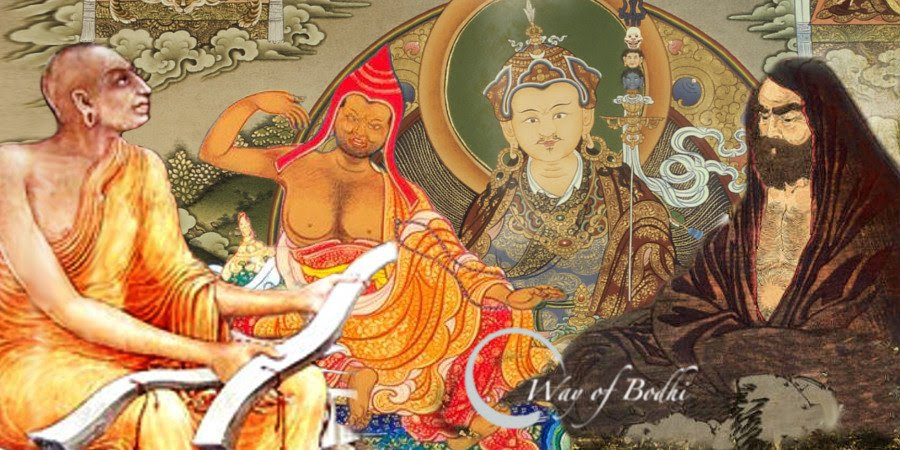
Dignaga (Mahayana logician), Padmasambhava (Vajrayana master) and
Bodhidharma (Zen master) all with connections to Kanchi.
(Kanchipuram) in Tamil Nadu was the most significant Buddhist center of
learning in South India. Kanchi produced world-renowned scholars and
masters of Buddhism such as Bodhidharma, Dignaga, Dharmapala,
Buddhaghosa, etc., spanning across Sravakayana and Mahayana. It is also
one of the twenty-four power places of the dakini (the spontaneous play
of the basic space) according to Vajrayana Buddhism. Guru Padmasambhava
too visited Dravida land and turned the wheel of Vajrayana there. For an
enthusiast in Buddhist history, Kanchi remains a treasure trove of
Buddhist statues and other pieces of archeological evidence still being
uncovered.
is so much to tell about this one place, Kanchi, that we could not make
this writeup any shorter
motifs, pillars, etc., that have something to tell about its Buddhist
past. We can spot ancient Buddha statues enshrined even in a police
station and a school.
rose to fame as a Buddhist center right from the 2nd Century BCE, when
Poompuhar, the earlier center in Tamil Nadu, submerged in the sea.
Buddhist presence in Kanchi finds mention in many Tamil Sangam texts
like Manimekalai, Silappatikaram, and Maduraikkanchi. According to the
Tamil epic Manimekalai, the Buddhist master Aravana Adigal was staying
in Kanchi, and he guided the protagonist, Manimekalai, in the path of
Buddhism. Manimekalai, according to the epic, is a Bodhisattva Bhikshuni
who spreads her compassionate activities to alleviate the suffering and
hunger of many and finally attains nirvana at Kanchi.
the time Xuanzang, the Chinese monk-traveler (7th century CE) visited
Kanchi, it was at the height of its glory. He recorded [Ref-1] about
hundreds of Mahayana viharas and 10,000 monks there. Xuanzang also
mentions about a 100 ft high Stupa built by Ashoka in Kanchi. About
people of Kanchi, Xuanzang wrote, “People there are courageous. They
deeply hold the principles of honesty and truth, and highly respect
learning. The monks there belonged to Mahayana and practiced the Vinaya
of Sthavira school.” Xuanzang also reported that there were about 80
Deva temples and many Nirgranthas (Jains).
we shall see, other reliable records indicate that Buddhist Mahayana
monasteries remained active in Kanchi even up to the 14th Century CE.
produced many great Buddhist masters and philosophers. Bodhidharma, the
founder of Zen Buddhism is said to be the son of the king of Kanchi
(possibly a Pallava king). The world acclaimed Buddhist logician Dignaga
is also from Kanchi. His disciple Dharmakirti is from a nearby place,
Trimala (Thirumala / Thirupathi). Aryadeva, the famed disciple of
Acharya Nagarjuna is also said to have lived in Kanchi during his last
days. Dharmapala, an abbot of Nalanda and a great master of Yogacara
Buddhism was also from Kanchi. He was the main teacher of Xuanzang.
Kanchi also produced Buddhaghosa, the author of Visuddhimagga, an
acclaimed practice manual of Theravada tradition. Dhammapala, another
famous commentator of Pali Suttas and Anuruddha Thera, the author of
Abhidhammatthasaṅgaha were also from Kanchi. According to the Vajrayana
tradition, Siddha Nagarjuna, one of the 84 Mahasiddhas was also from
Kanchi.
to Tibetan Buddhist master Jetsun Taranatha, Guru Padmasambhava (Guru
Rinpoche) visited the Dravida land (Tamil Nadu) in the 8th Century and
taught Sutra and Vajrayana Buddhism there for 12 years. Taranatha
narrated this based on the accounts of Indian masters that he could
access in the 16th Century. Since in the 8th Century Kanchi was one of
the most important Buddhist centers in the Dravida land, Padmasambhava
would have blessed Kanchi with his presence and taught there. According
to Taranatha, even at his time (16th-17th Century CE), Guru Rinpoche’s
lineage of Vajrayana practices was active in Dravida land.
per the inscriptions from the excavation of a renowned Buddhist vihara
at Kurkihar near Gaya, Bihar (9th/11th Century CE), many statues found
there were donated by people from Kanchi. This indicates that Kanchi was
flourishing with Buddhism even in that period. In the 13th Century,
Marco Polo, the European traveler, saw seven Pagodas (chaithyas) on the
seashore of Mahabalipuram near Kanchi. In the 14th Century, an eminent
poet of Java mentioned in his writings about the presence of thirteen
Buddhist monasteries in Kanchi [Ref-2, p. 97]. According to a 14th
Century inscription in Korea, Dhyanabhadra from Kanchi went to Korea in
1370CE and established a Mahayana monastery (Zen / Seon) there [Ref-3,
p. 7]. The inscription also mentions that he received the teaching of
Avatamsaka Sutra in Kanchi. All these records indicate that Buddhism was
very much alive in Kanchi even in the 14th Century, though in a phase
of gradual decline.
of the ancient Viharas (Buddhist monasteries) of Kanchi that find
mention in historical works are Raja Vihara and Mulasoma Vihara. None of
them are as such identifiable now. An 11th Century Manuscript of
Prajna-paramita-sutra obtained from Nepal [Ref-4], has a miniature
painting of a statue of Vasudhara Tara from a renowned Mahayana Vihara
in Kanchi.
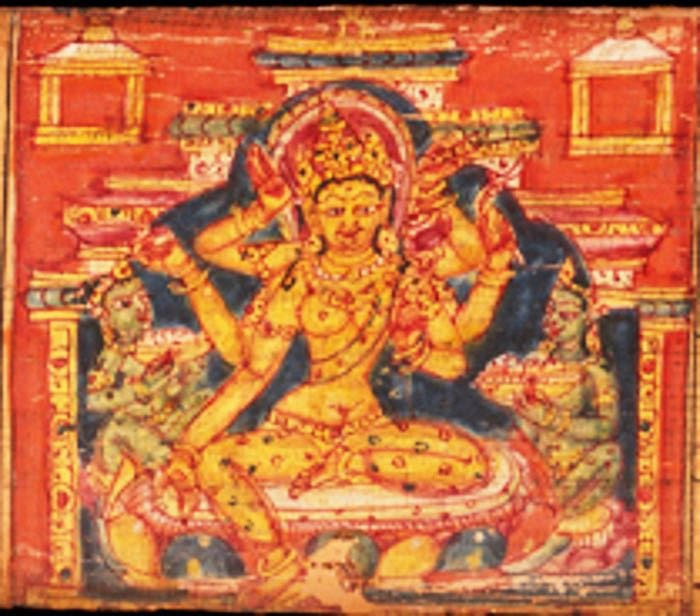
to Vajrayana Buddhism, Kanchi is one of the twenty-four sacred power
places. As per many Vajravarahi and Chakrasamvara Sadhanas Kanchi is the
heart of the Dakini (the spontaneous play of the basic space) and a
sacred place of Dakinis (where the vibrancy of wisdom activities
naturally plays out). Even according to some of the Tantras revealed in
Tibet, e.g., Yumka Dechen Gyalmo of Longchen Nyingthik, Kanchi is at the
heart of the dakini (Yumka, the Great Bliss Queen).
of now, Kanchi has two main areas, Siva Kanchi and Vishnu Kanchi,
dedicated to many temples of Lord Siva and Lord Vishnu respectively.
There is also a Jina Kanchi where two Jain temples exist even today. We
do not find a separate Buddha Kanchi here now, however, Buddha and
Bodhisattva statues and motifs can be seen all around the present-day
Siva Kanchi and Vishnu Kanchi.
following is the list of archeological evidences that still remain of
the grand and vibrant presence of Buddhism in ancient Kanchi. We
explored these with the purpose of revealing history. However, the
essence of Buddhism is not about statues but about cleansing our minds.
And, hence there is no intention of making claims on statues or places.
Read Dealing with History without Attachment for more details on how to
stay clear of afflictive emotions and deal with History without
attachment.
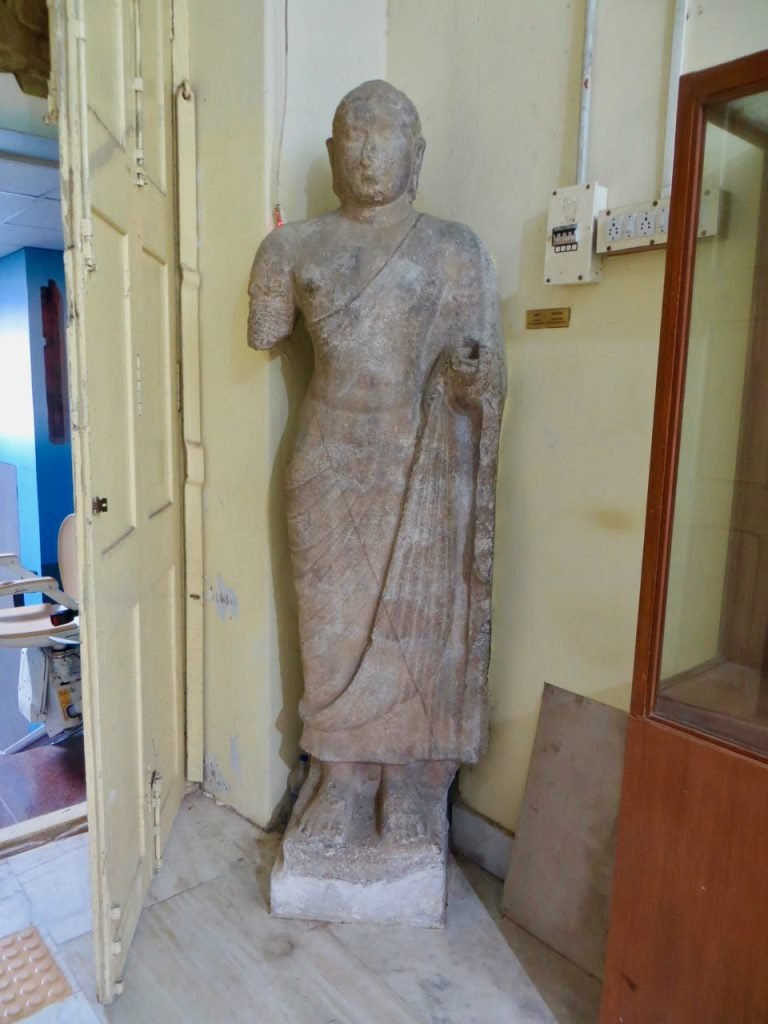
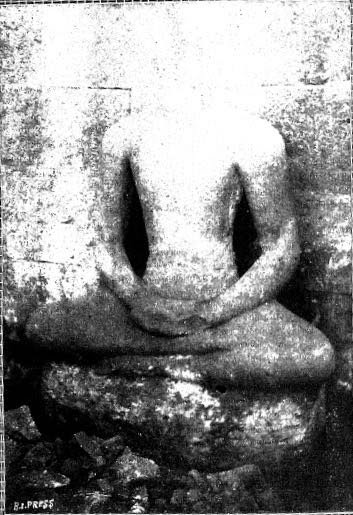
Temple, reported by Gopinatha Rao a century back, but not traceable now.
Could be in a Museum reserve.
earliest of the Buddha statues found from Kanchi is a standing Buddha
statue from the 5th Century CE of a majestic height of 8ft. It resembles
Amaravati and Gandhara statues in style. This is now kept in the
Chennai Museum. According to the archeologist Gopinatha Rao (d. 1919)
[Ref-5, p.128], during his time, this statue was in the inner prakara of
the Kanchi Kamakshi Temple in Siva Kanchi. One more Buddha statue was
found in the outer prakara in a broken condition. Gopinatha Rao inferred
that Kanchi Kamakshi Temple was originally a temple of Tara. When we
correlate with other connections that can be seen, a link to Vajrayana
Buddhism can be inferred for this temple. The principal deity of this
temple is Kamakshi (meaning, the passionate eyed one). They practice
Srividya tantra (which in Tibetan means,དཔལ་ལྡན་རིག་པ) and the tantric
deity according to that tantra is Lalita Tripura Sundari
(ཁམས་གསུ་རོལ་པའི་མཛེས་མ།). Nature and hand emblems of Kamakshi are same
as Kurukullā (Red Tara) of the Vajrayana Buddhist tantras. The emblems
are — hook (ankusha), noose (pāśa), flower-arrow and sugarcane-bow.
However, the current idol is in a formal sitting posture, not in the
usual dynamic form of kurukullā. There were also two miniature Buddha
carvings (one sitting and one standing) on a stone pillar of the temple
when we visited in 2012.
2. Buddha statues from a school
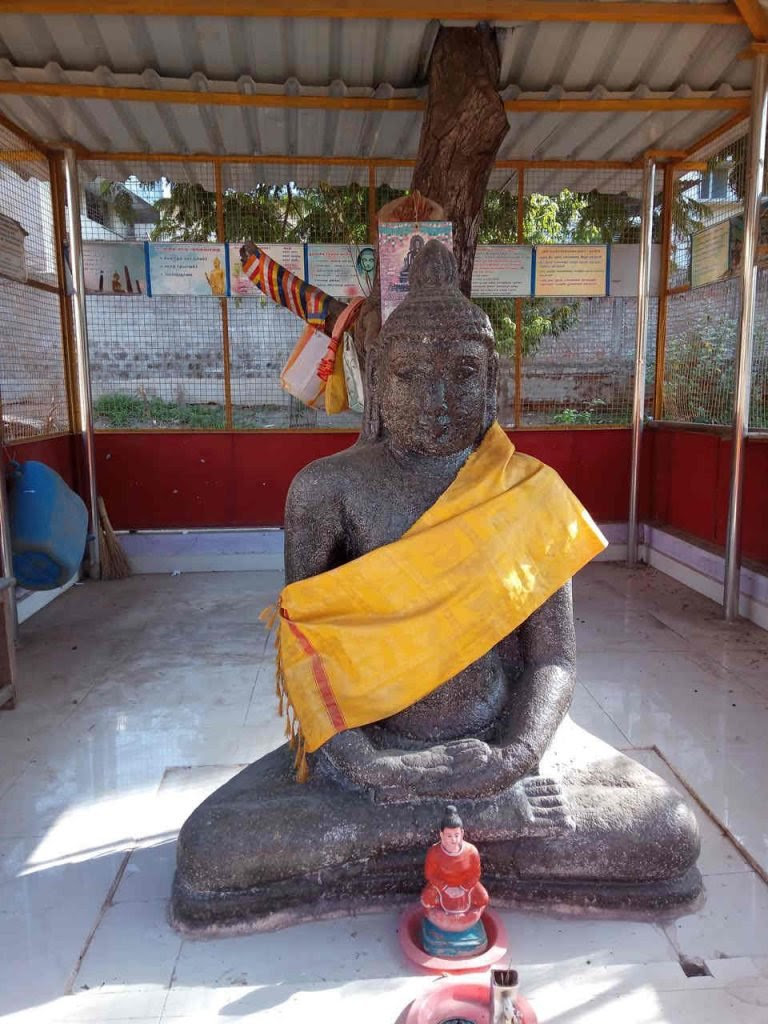
one of the earliest of the Buddha statues of Kanchi is kept in Govt. C.
M. Subbaraya Mudaliyar Higher Secondary School, next to Kanchi Kamakshi
Temple. This statue is from the 5th-6th Century CE and is of a height
of 5’6”. According to Gopinatha Rao [Ref-5, p.129], this statue was in a
garden adjacent to Kanchi Kamakshi Temple. Probably, the school came up
in the garden later. The earlier photos of this Buddha that we could
access are with his eyes closed. Recently, someone seems to have tried
to ‘improve’ it by chiseling open the eyes. According to Gopinatha Rao,
there are two more Buddha statues under the soil there yet to be
excavated. Even though more than 100 years have passed, it is still not
excavated. (Gopinatha Rao was an archeologist during the British rule.)
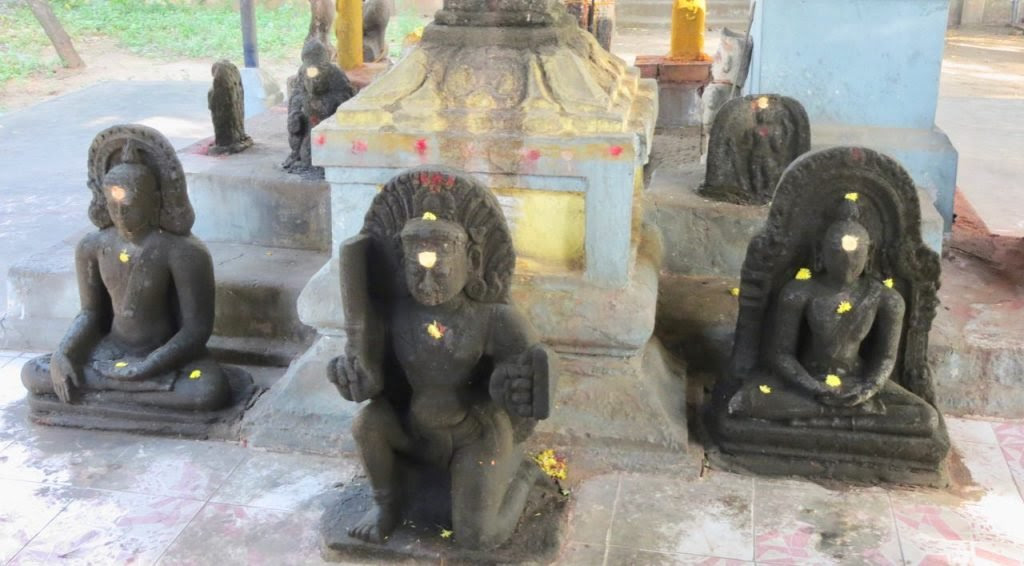
Buddha statues got from the vicinity of this temple are kept there for
safe-keeping. One with Bhumisparsha mudra and the second one in dhyana
mudra.(Both from the 12th Century CE. One of height 3’9” and another of
2’6”.)
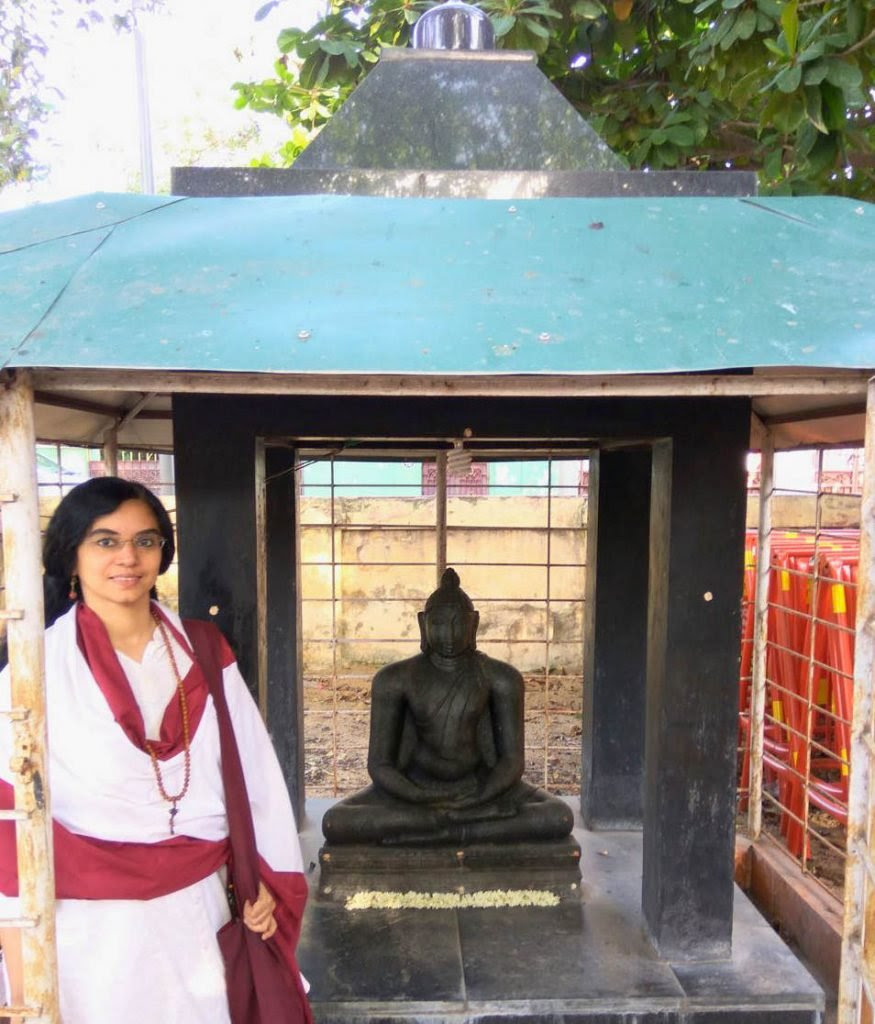
Kanchi Police Station, adjacent to Kanchi Kamakshi Temple also hosts
one of the ancient Buddha statues unearthed from the vicinity. This was
installed in the police station in a mandapa, as desired by Walter
Dewaram, the then DGP of Tamil Nadu. According to archeologists, this
statue is from the 11th Century period.
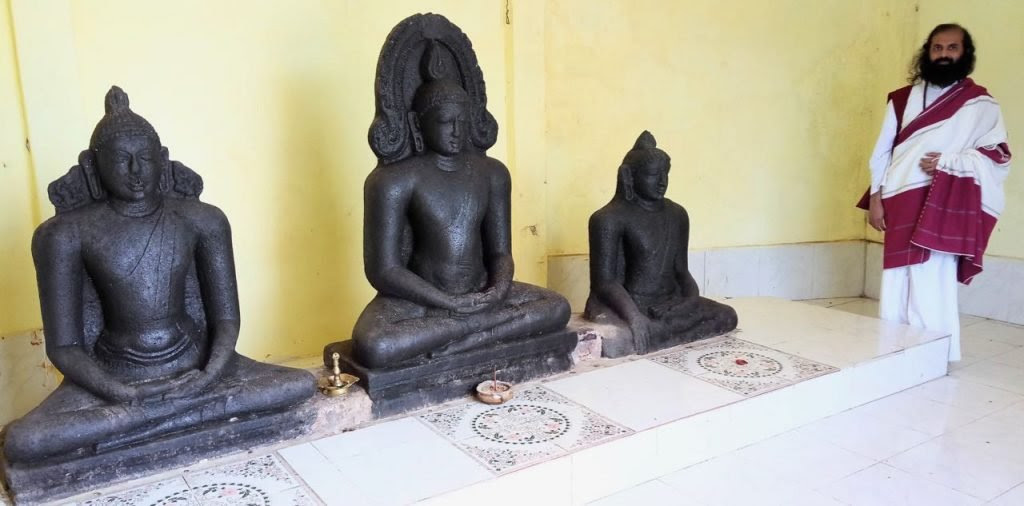
the outskirts of Kanchi, at Pallur, three Buddha statues were unearthed
from the fields more than a hundred years ago. These could be from the
10th-12th Century. In 1999, a new Buddhist temple was constructed and
the Buddha statues are installed in that hall.

the outskirts of Kanchi, at Kanikiluppai a Buddha statue was discovered
from the fields. (belonging to the 10th-12th Century period). A statue
of a Jain Tirthankara was also obtained. These statues were stolen once
in the recent past and then recovered by the police. Since then, both of
these are kept inside a Pillayar (Ganesha) Temple in Kanikiluppai for
safe-keeping till a separate shrine could be made for these statues.
There is also a pillar in the vicinity that is either a Buddhist or Jain
one.
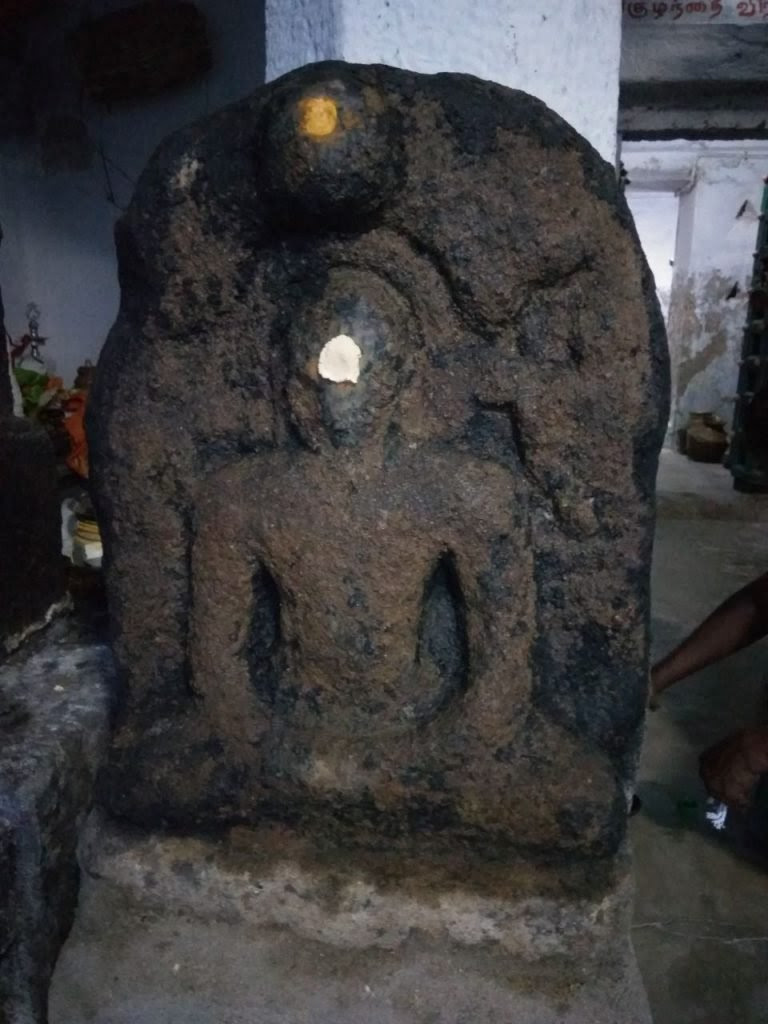
7. Reclining Buddha (lost) at Ekambareswarar Temple

compound wall of Ekambareswara Temple uses many large stone bricks with
carvings of the Buddha. (from the 14th century according to
archeologists). These Buddha carvings are not in a particular order, so
most likely this was simply the reuse of the stone blocks from a
dilapidated Buddhist structure. There was a large reclining Buddha
statue lying in the temple compound earlier [Ref-6]. According to the
archeologists, this was from the late Chola period (11th to 13th
Century). However, this is lost now. It could not be traced to any
museum and nobody knows where it went.

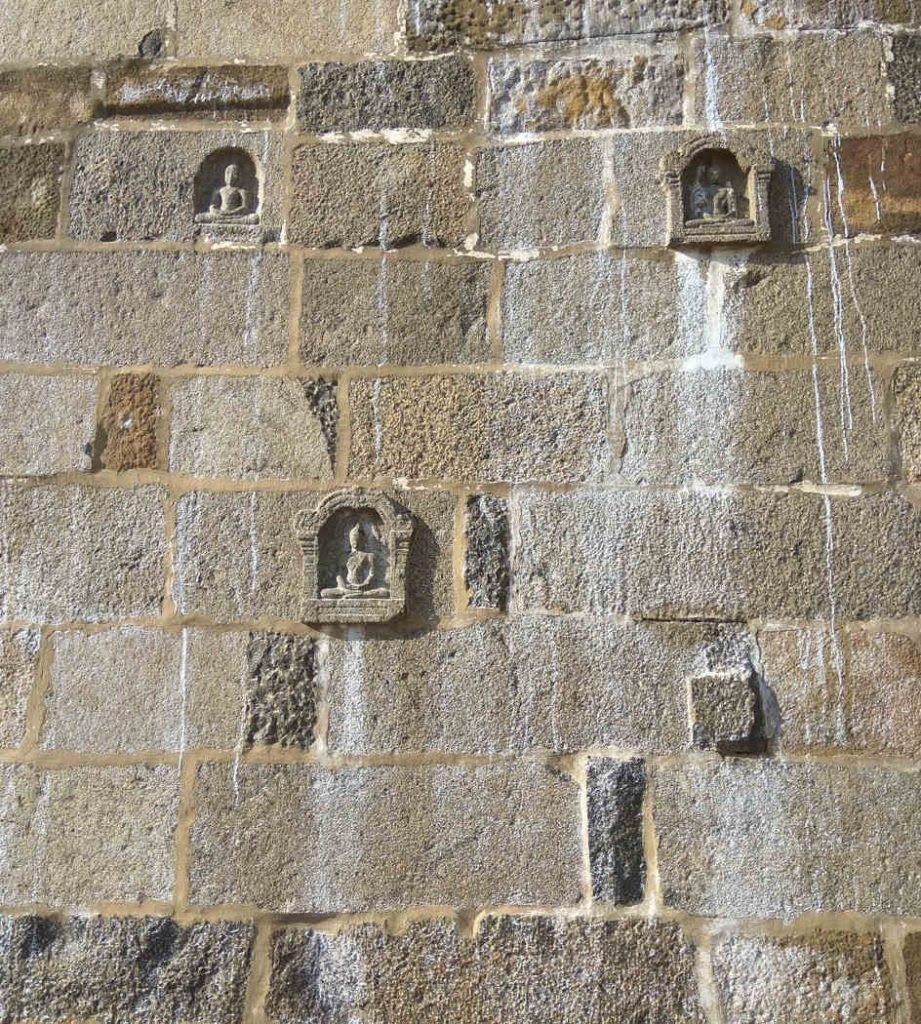
8. Buddha pillars at Kachapeshwarar Temple

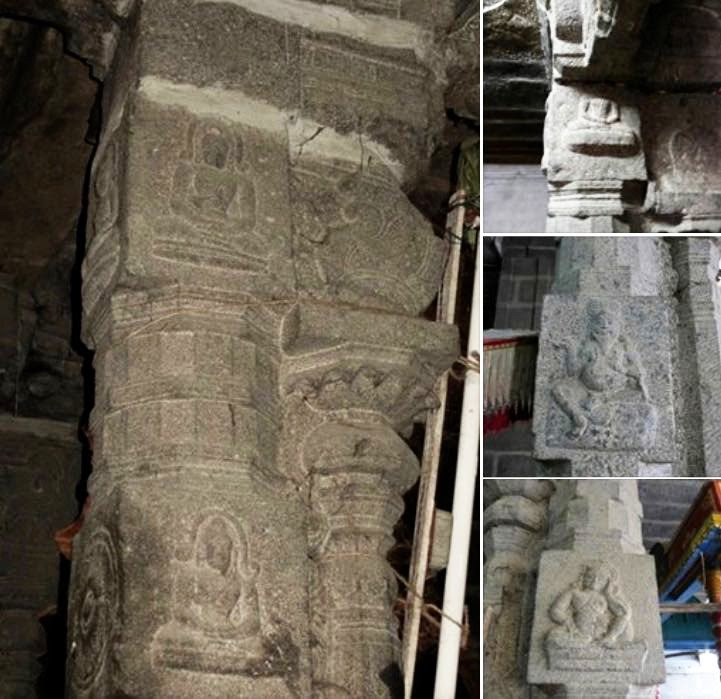
images of Buddha, Bodhisattvas and Buddhist Yogis can be seen chiseled
in the pillars of Kachapeshwarar Temple in Kanchi. These pillars do not
have a particular order, and it looks like that they were adjusted in
height post-sculpting to fit for the current mandapa. From this, it may
be inferred that these could be the reuse of the pillars from an earlier
dilapidated Buddhist structure.
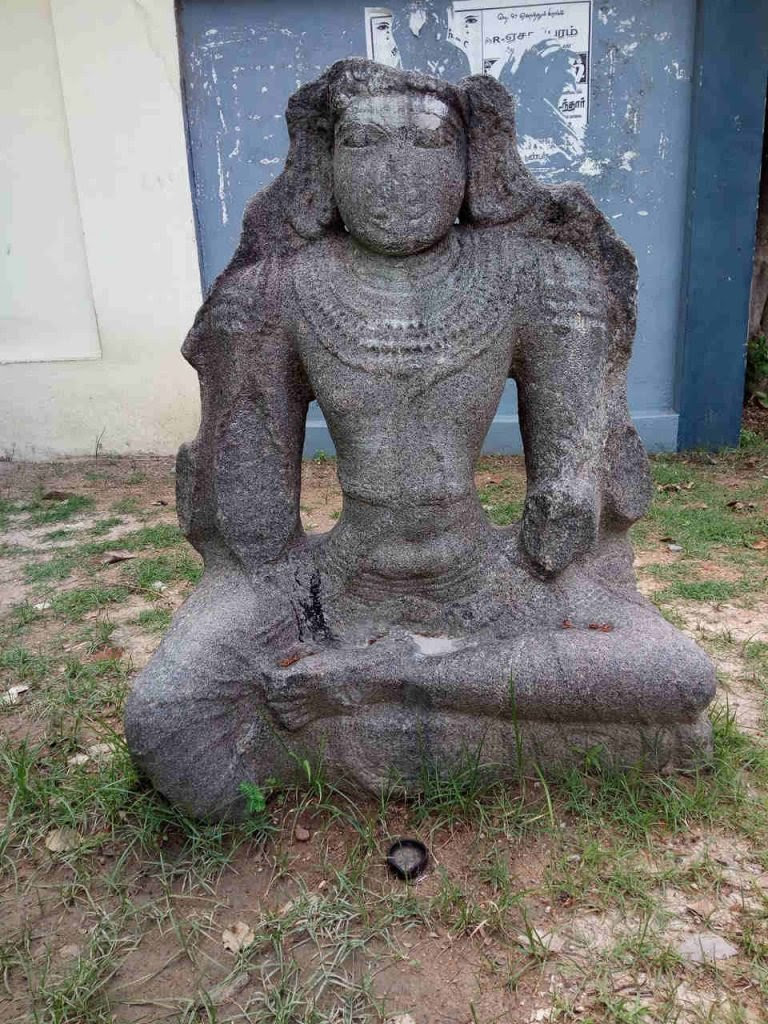 A broken statue in Enathur, Kanchi, which is possibly of Avalokitesvara.
A broken statue in Enathur, Kanchi, which is possibly of Avalokitesvara.
broken statue and a pillar with dharma-chakra are abandoned near the
road-side in Enathur. The statue seems like that of Avalokitesvara in a
four-handed form. There is also another Dharma-chakra nearby that is
enshrined as a small temple and people worship that. The shrine is named
as ‘Sannyasi-amman Alayam’.
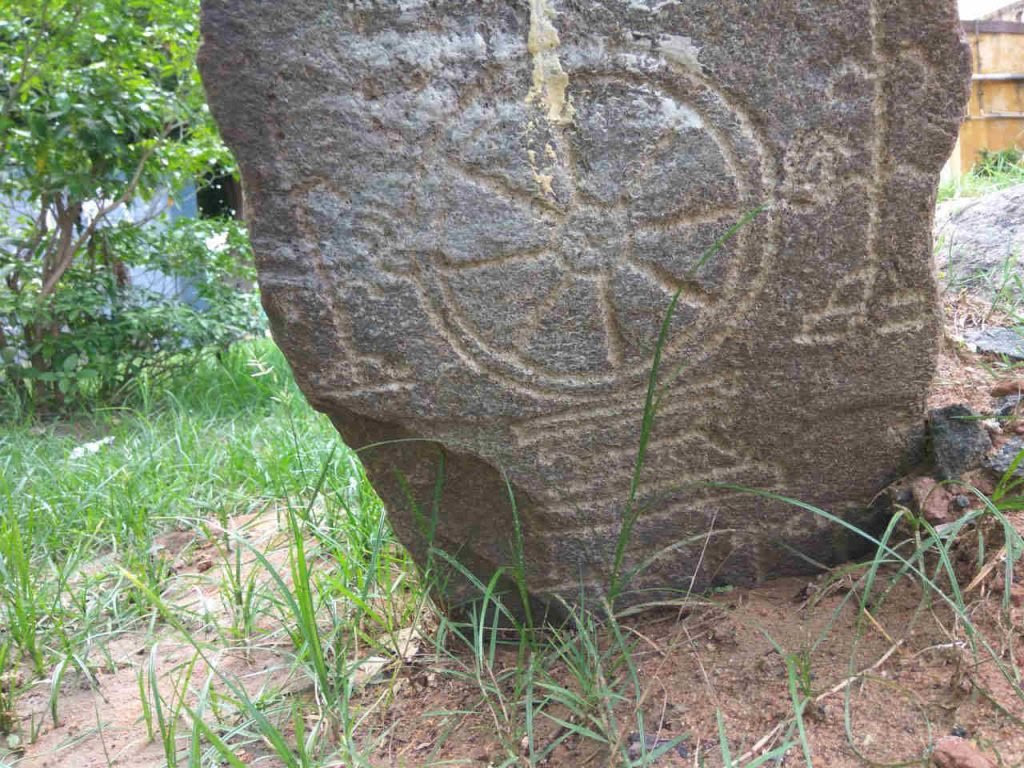
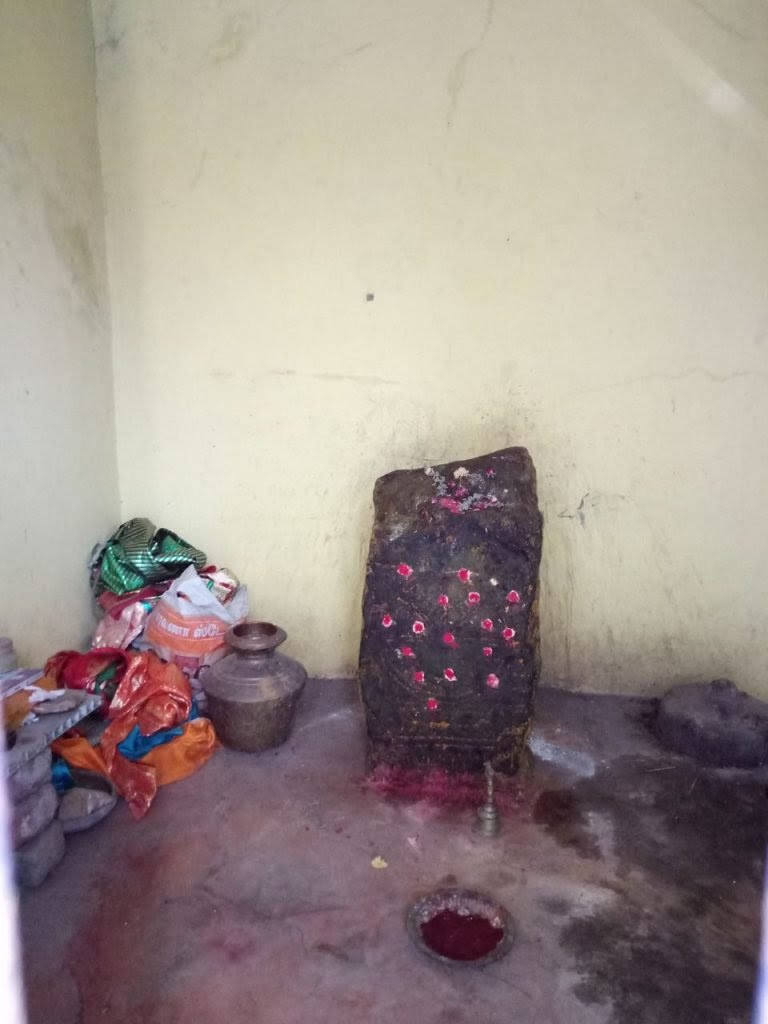
10. Buddhist Dhamma centre at Konerikuppam
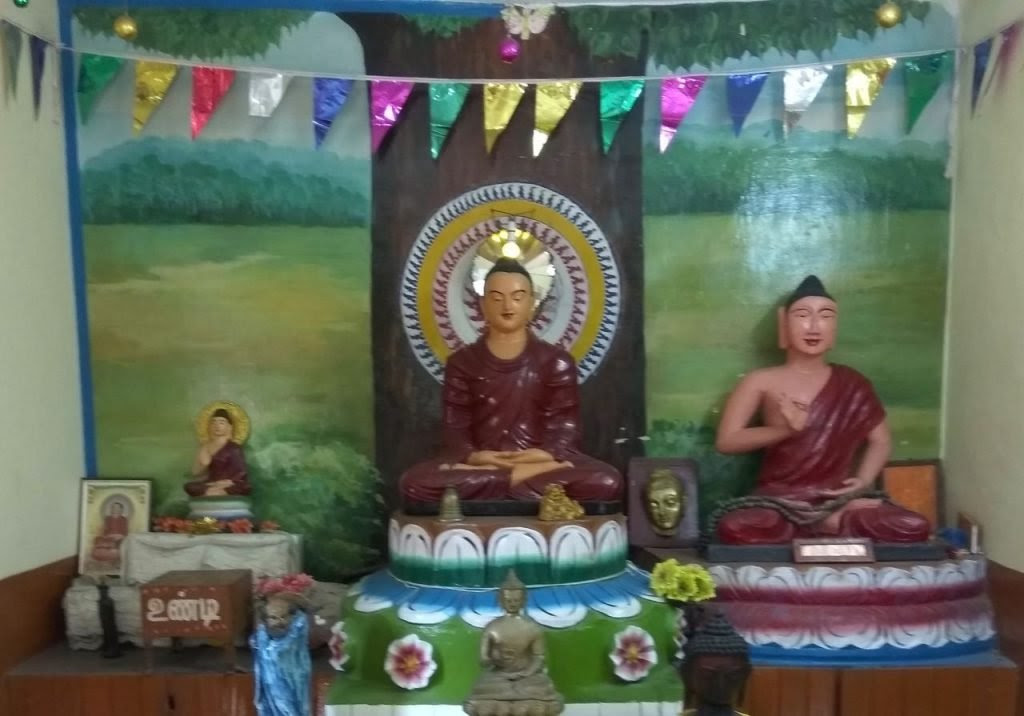
ancient pillar with the carvings of Buddha and Bodhisattvas and another
Buddha head are preserved in a new Dhamma centre at Konerikuppam. Mr.
Chandrashekar and his wife started this centre many decades back when
they got an ancient Buddha head abandoned under a tree. He added a body
to that and enshrined it. Later, he chanced upon an ancient pillar that
was used as a stepping stone in front of a shop. The pillar had the
images of the Buddha and a Bodhisattva (possibly Maitreya). He salvaged
that and installed that too in front of his temple.
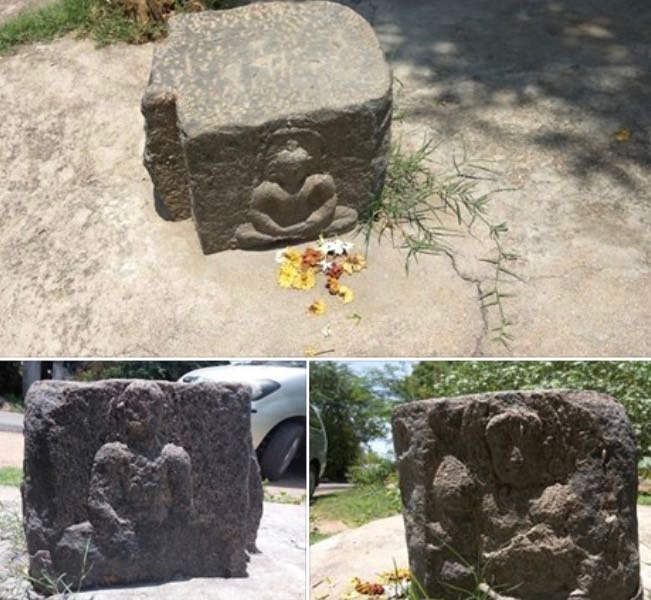
11. Buddhas in Arpakkam
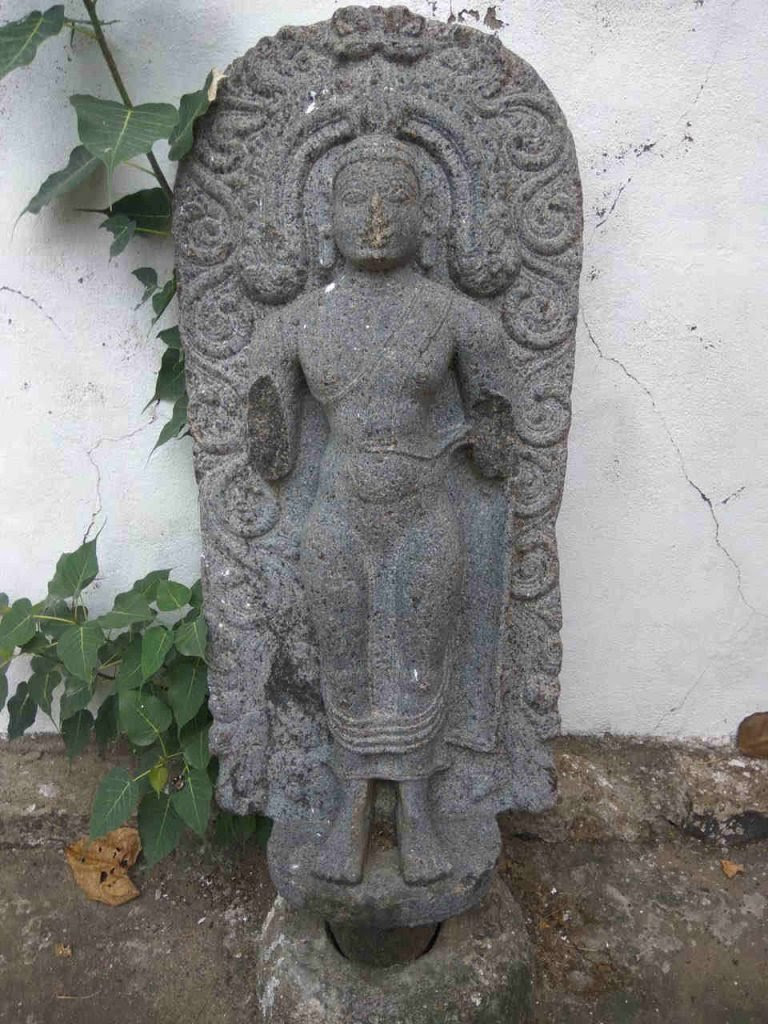
the outskirts of Kanchi, in Arpakkam, there is a small standing Buddha
statue (of about 2ft) kept in the corner of a Perumal (Vishnu) temple.
There was also a bigger sitting Buddha statue kept within this temple
earlier. However, that was stolen and not yet recovered. A third one, a
headless Buddha statue is lying in the jungle just outside the temple.
There is also a pillar with dharma-chakra carving near that place.
Locals worship the pillar as a guardian deity.

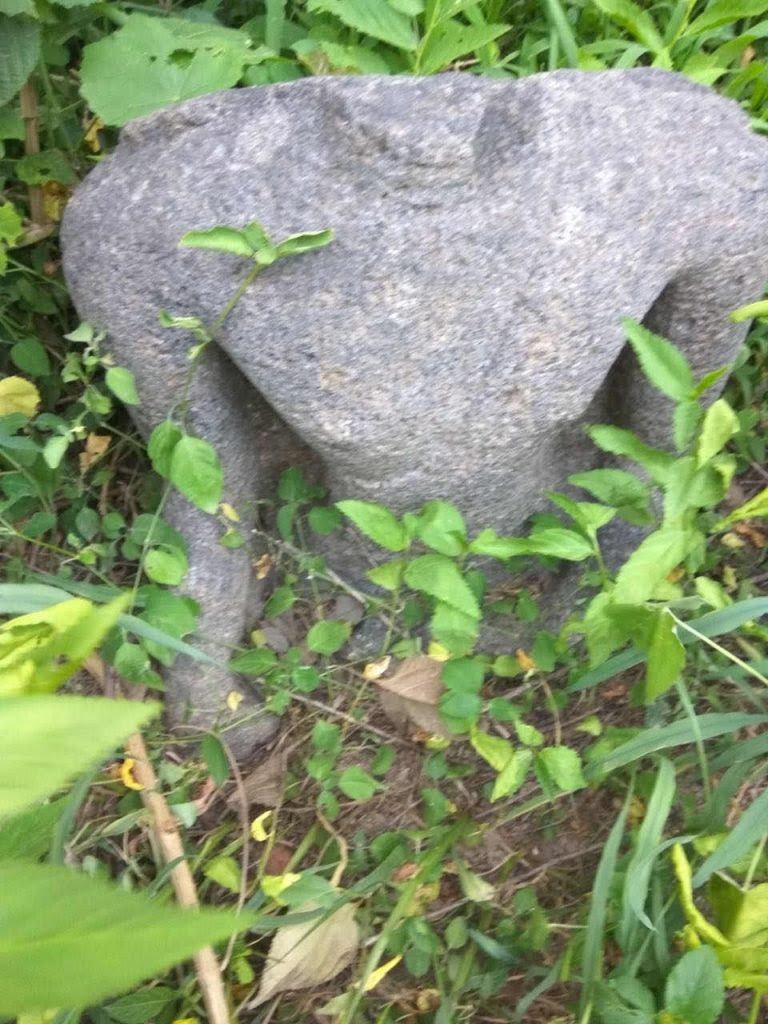
12. Buddha statue from Koovam
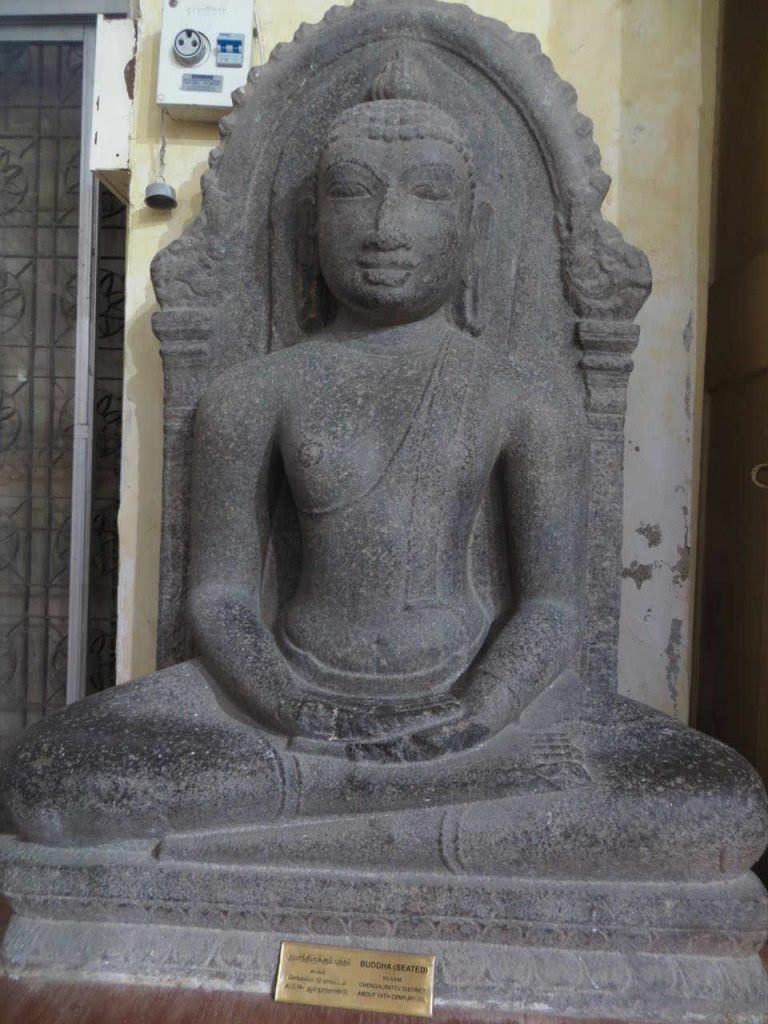
near Kanchi, from Koovam (Thiruvallur district), a Buddha statue was
obtained that is now kept at Chennai Museum. According to the museum
records, this statue is from the 14th Century.
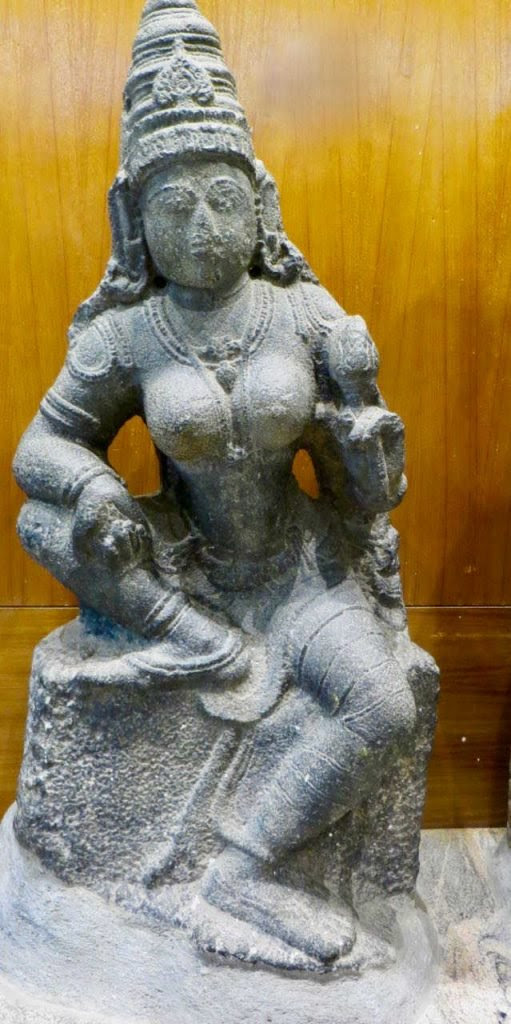
11th Century statue obtained from Sholingur, near Kanchi, is now kept
in Chennai Museum. This may be identified to be Tara. However, the right
palm is slightly folded and there is no lotus seat. It could probably
be Vasudhara, the Yellow Tara of prosperity. An 11th Century manuscript
of prajna-paramita-sutra preserved in Cambridge University too has a
miniature painting of another statue of Vasudhara from a renowned
Mahayana Vihara in Kanchi [Ref-4]
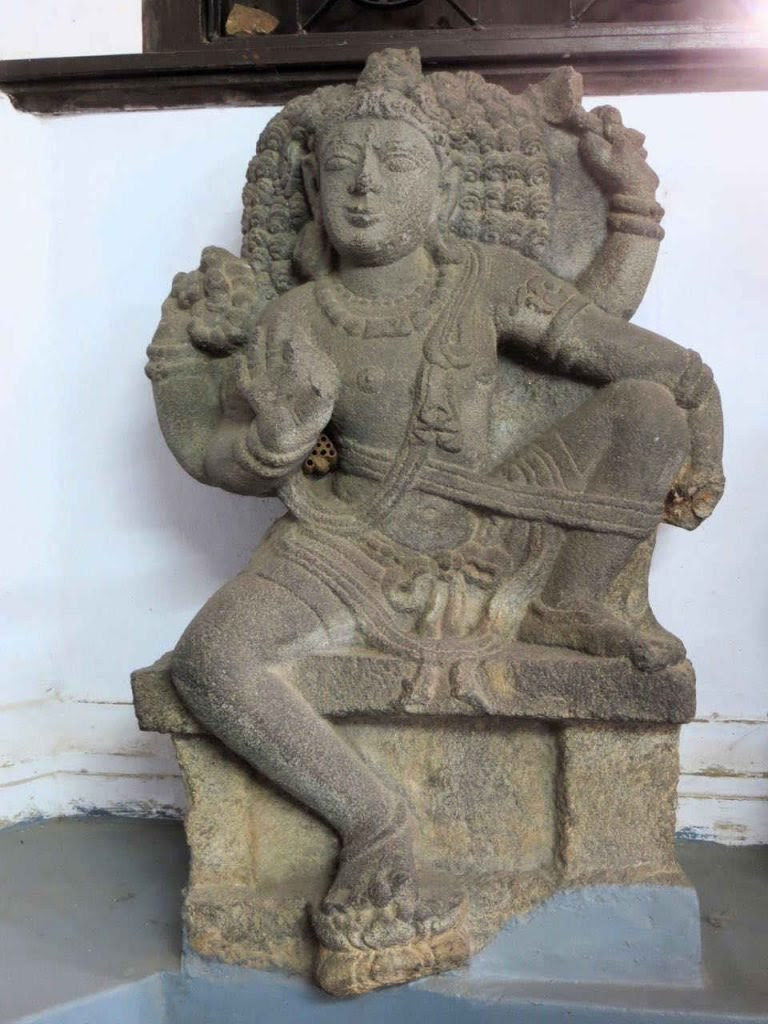
An Avalokitesvara statue obtained from Kaverippakkam near Kanchi is
now at Chennai Museum. Here Lokesvara is in his yogi form with
meditation belt and matted hair, a form very popular in the South. More
about Avalokitesvara forms and their influence on other statues will be
discussed in a later post.
Conclusion
Years back, when we first visited Kanchi, we were enthusiastic about
seeing a few Buddha statues reported there as a rarity. Later, T N
Gopinatha Rao’s archeological records from a century ago brought more
information. We also got leads from some web and news articles about
Buddha statues found in Kanchi. In our recent visit, we met Mr.
Chandrasekar of Kanchi who runs a Dhamma centre there. Thanks to his
help, we could find a lot more Buddha statues in the outskirts of Kanchi
this time.
More and more Buddha statues are being unearthed all around in
Kanchi. Some of them are kept nicely in some small shrines made with the
sponsorship of people from Thailand and so on. And, some others are
lost. Since many Buddha statues are on the street-side and unprotected,
some are stolen. Unless some action is taken by the government to secure
the other statues, more of these historic monuments may be lost soon.
Exploration of Kanchi continues.
References
Ref-1 – Xuanzang. (1884). Great Tang Records on the Western Regions.
(Samuel Beal, Trans.). Buddhist Records of the Western World. London:
Trubner & Co. (Original text 6th century CE).
Ref-2 – K. Krishna Murthi. (1991). Glimpses of Art, Architecture and Buddhist Literature in Ancient India: Abhinav Pubns.
Ref-3 – B. V. Bapat (Ed.). (1971). Two Thousand Five Hundred Years of Buddhism.
Ref-4 – Cambridge, Cambridge University Library: Add.1643. (Aṣṭasāhasrikā Prajñāpāramitā Sūtra manuscript.).
Ref-5 – T.A.Gopinath Rao. (1915). Bauddha Vestiges in Kanchipura ,The
Indian Antiquary, A Journal of Oriental Research, Volume XLIV – 1915.
p.127.
Ref-6 – P.R. Srinivasan. (1960). ‘Story of Buddhism with Special
Reference to South India’, A. Aiyappan and P.R. Srinivasan (Eds.).
Buddhist Images of South India: Department of Information and Publicity,
Government of Madras.




![Srimala Sutra: All 15 Chapters [English Tathagatagarbha Sutras Audiobook] (1080P)](https://external.fblr15-1.fna.fbcdn.net/safe_image.php?d=AQEPgI28xlaP6DUo&w=500&h=261&url=https%3A%2F%2Fi.ytimg.com%2Fvi%2FSOYlzJjSQxc%2Fmaxresdefault.jpg&cfs=1&sx=0&sy=17&sw=1280&sh=668&ext=jpg&_nc_oe=6ef65&_nc_sid=632586&ccb=3-5&_nc_hash=AQHsr58v2Wi4mbHV)


